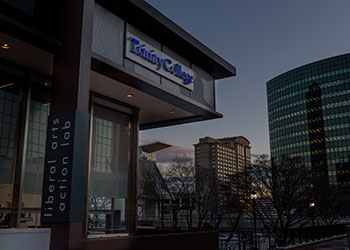Trinity Professors, Administrators, and Initiatives Highlighted in Recent Coverage
Hartford, Connecticut, June 29, 2018 – In recent weeks, several members of the Trinity College faculty and administration have been featured in media coverage by local, national, and international publications and digital media outlets.
The New York Times published a letter to the editor by Sonia Cardenas, dean of academic affairs and strategic initiatives and professor of political science, in response to Times Columnist Frank Bruni’s piece about some liberal arts colleges choosing to eliminate majors. In her letter, appearing with other letters on the same topic under the header, “Don’t Scrap the Liberal Arts Majors,” Cardenas wrote, in part, “Majoring in a field isn’t so much about specialization. It’s about learning to learn and think deeply, to appreciate the quality of ideas and the importance of context, to learn tools and methods of analysis, and to imagine alternatives and apply knowledge acquired through practice and hard work.”
In an article titled “Changing Higher Ed to Maintain Hope of Social Mobility,” Angel B. Pérez, vice president for enrollment and student success, wrote, “While the higher education sector is currently challenged, it remains the greatest hope for ensuring that Americans compete in a rapidly evolving global workforce.” Pérez went on to delve into the multiple ways to tackle barriers that limit access to a college education. His article is featured on the blog of the Higher Education Committee of 50, also known as “Forward 50,” a group of 50 forward-thinking higher education leaders—Pérez is one of them—who were invited by the National Association of Student Financial Aid Administrators (NASFAA), through a grant from the Bill & Melinda Gates Foundation, to develop policy solutions to help surmount obstacles preventing students from enrolling in, paying for, and graduating from college.
In its article “Bonding with Loctite,” The Manufacturer magazine, based in London, detailed the history of Super Glue and other Loctite adhesives having been first developed in the 1950s in the Trinity research lab of the late Vernon K. Krieble, Scovill Professor of Chemistry, Emeritus. The article noted that the “entrepreneurial professor…discovered how to make an anaerobic sealant using methacrylate. ‘Anaerobic’ means the substance will harden in the absence of air. This sparked a massive demand from engineers across the globe, who had since the dawn of the age of nuts and bolts endured endless issues with nuts that worked loose under pressure or vibration, or even just time. …The savings in maintenance time were huge, thanks to a few drops of Krieble’s wondrous invention.”

downtown Hartford. Photo by Nick Caito
Trinity’s present-day efforts to support and encourage entrepreneurship and innovative activity in its home city and region were the subject of a Q&A with President Joanne Berger-Sweeney, published on the “Innovation Destination Hartford” website. Among the topics discussed was Trinity’s participation in the Hartford/East Hartford Innovation Places Planning Team that was selected to receive a share of $30 million in statewide funding to spark economic development and investment in innovation in the region. In the interview, Berger-Sweeney also talked about Trinity’s partnership with Capital Community College in opening the Liberal Arts Action Lab at 10 Constitution Plaza in downtown Hartford’s central business district.
A Hartford Courant article, “Hartford Data Lab Looks
for Links Between Health and Housing,” spotlighted community research that faculty and students at the Liberal Arts Action Lab are partnering on with the Connecticut Data Collaborative, a nonprofit organization that is moving into office space at Trinity’s 10 Constitution Plaza location this summer. Courant reporter Rebecca Lurye wrote, “a team of [Connecticut Data Collaborative] staff and Trinity interns will dig through data to measure the relationship between housing issues, such as eviction, foreclosures, blight and unsafe conditions, and residents’ health, including the rate of chronic illnesses and preventative measures like having health insurance and visiting the doctor.”
WFSB Eyewitness News, the local CBS affiliate television station, covered Trinity’s fifth annual Mobile CSP App Expo with a video story, “CT students showcase mobile app designs.” At the expo, which took place in Mather Hall’s Washington Room, Trinity welcomed to campus students from local high schools who demonstrated the mobile phone apps they designed and developed during the school year. The high school students worked under the tutelage of their computer science teachers, all of whom received special training through Trinity’s Mobile Computer Science Principles (CSP) Project. In wrapping up the story, WFSB’s anchor noted Mobile CSP’s far-reaching impact, saying, “What a great project. And it’s now teaching more than 10,000 students nationwide.”
